I tested out the Duolingo Hungarian course for 30 days to see if it’s worth doing.
This Duolingo Hungarian review will go into detail on whether I think it’s worth doing the Duolingo Hungarian course as well as the positives & negatives of the course.
The review is broken up into different sections and I’ve gone into detail on how good Duolingo Hungarian is in teaching you to speak, listen, read and write in Hungarian.
Table of Contents
Summary
Here I’ve written a brief summary of my thoughts on the Duolingo Hungarian course. After this summary, I have gone into much more detail into the course, what you’ll learn and more.
Related Post: Is Hungarian Hard To Learn For An English Speaker + How Long Does It Take To Learn?
Good Things About Duolingo Hungarian
- The course has audio clips for every word and phrase.
- They introduce relevant and useful words.
- The course builds on concepts you’ve already learnt whilst introducing new words as you go.
- It is fun to do which helps motivate you to continue learning.
- It’s free.
Bad Things About Duolingo Hungarian
- Virtually no speaking practice – the course mainly focuses on reading and writing.
- Limited guidance on pronunciation.
- Sometimes the pace was too fast – a lot of new words or complex sentences were introduced which reduced the time available to consolidate older words.
- At times they introduce strange or irrelevant sentences.
- Explanations on grammar points can include lots of jargon and sometimes are difficult to understand.
- Encourages bad habits with spelling.
Would I Recommend Duolingo Hungarian And Who For?
I would recommend using the Duolingo Hungarian course as an introduction to the language.
You won’t be able to learn to speak fluent Hungarian from this course – that would require a lot of other input such as videos, audio courses, books and more.
This course will teach you some basic words and phrases and will also give you an introduction to Hungarian grammar including different verbs and cases.
I’d recommend this course for someone just starting out with Hungarian if they want a fun way to try the language out for FREE before investing in a more comprehensive resource.
Alternatives To Duolingo Hungarian
There are many other Hungarian courses out there that will teach you to speak at a fluent level much better than Duolingo.
My top recommendation is Pimsleur Hungarian which is better for complete beginners that want to learn to speak.
Another great option for learning Hungarian is Glossika. This is better for low intermediate learners and is particularly good to expose yourself to a large number of phrases.
Another free resource is the HungarianPod101 YouTube channel.
Background Information
Here’s a bit of background information on myself to give you some context to this review.
I did the Duolingo Hungarian course for 30 days in a row and each day I did 20 minutes of Duolingo practice.
During the 30 days, I did no other Hungarian courses and only learnt Hungarian from the Duolingo course.
I’ve never studied Hungarian before doing this course and I’ve also never studied a similar language.
What Did I Learn In The Duolingo Hungarian Course?
Having spent 30 days (20 minutes each day) studying Hungarian with Duolingo, I did actually learn lots of useful vocabulary, verbs, phrases and grammar points.
So what did I actually learn?
According to Duolingo, I learnt 576 words in the 30 days.
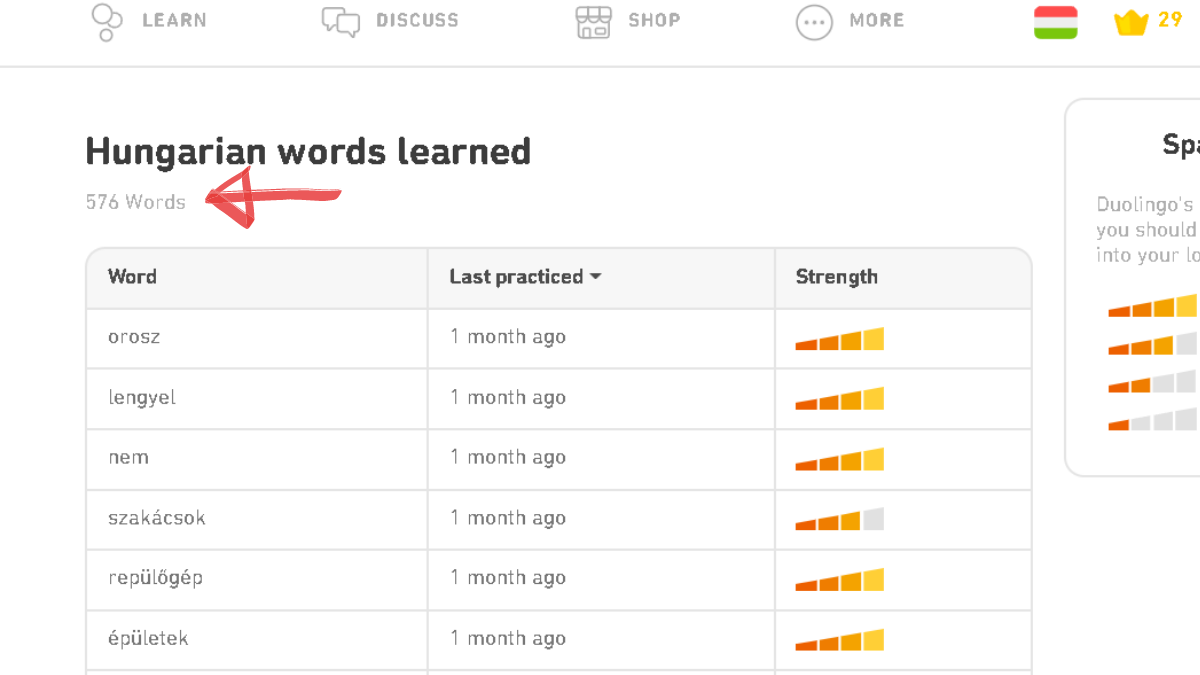
Duolingo breaks up the language into different topics and each topic will have a different focus. For example, some of the topics I learnt included names, jobs, places, adjectives, plurals etc.
Below are some examples of words I learnt:
Noon, evening, airplane, chair, apple, window, table, bank, hospital, department store, city, man, woman, boy, girl, big, small, red, black, where, behind, good.
Below are some examples of verbs I learnt:
To hurry, to play music, to chat, to rest, to sing, to wash dishes, to search, to want, to sit, to run, to wait.
Below are some examples of phrases/sentences that I learnt:
- The girl is standing in front of the tall building
- The woman walks in front of the building
- The hotel is between the airport and the city
- Are these apples?
- What are those?
- I see cars in front of the school
- The rich, old woman is eating lunch in front of the expensive restaurant
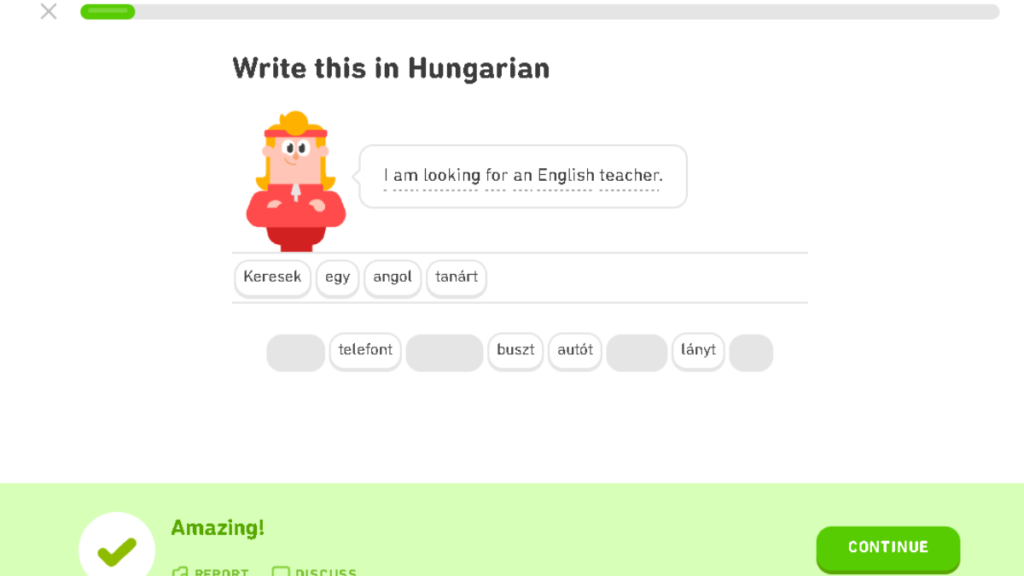
These are just a few examples of words, verbs and sentences that I learnt during my 30 days on Duolingo. There are plenty more things that I learnt in addition to these.
As you can see there is a range of sentences with some of them being quite challenging for a beginner.
There are also some strange phrases taught which I will discuss in more detail later in the vocabulary section.
One thing to note is that the 576 words learnt are are all words and phrases that have come up in the course but I think it’s fair to say that even though Duolingo says that I have learnt 576 words I definitely have not committed all 576 to memory.
Duolingo Features & Teaching Style
Duolingo Hungarian Course
At the time of writing the Duolingo Hungarian course is currently in ‘Beta’ meaning it is not a complete course.
The Duolingo Hungarian course has 4 units with 78 different topics. Each topic contains 5 levels with a few lessons on each level.
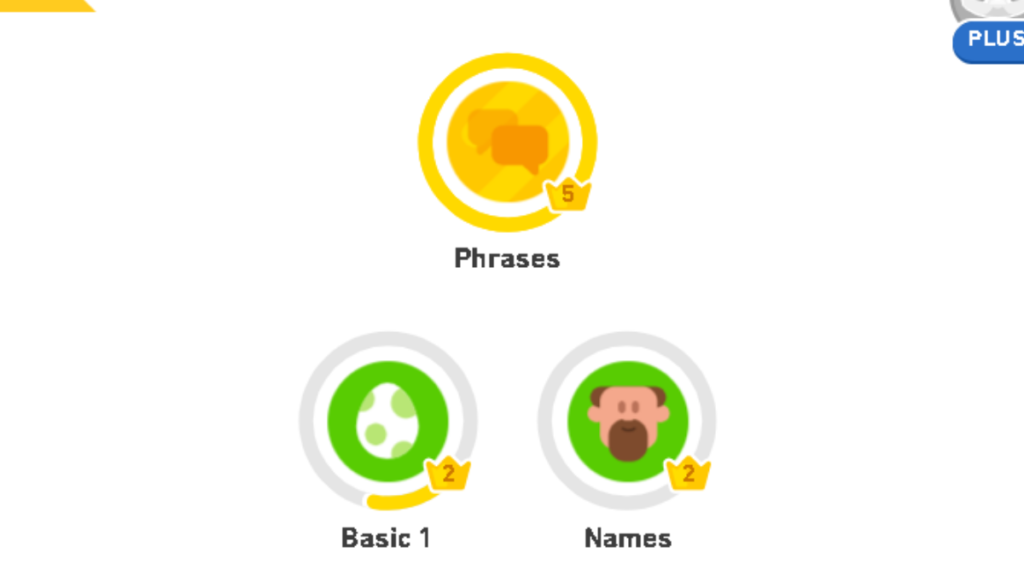
Tips
Each of the 78 topics comes with a ‘tips’ page.
This is usually just a bit of information about what will be covered in the new lessons and usually explains the grammar points in more detail.
Overall I found that the tips pages were fairly helpful in explaining concepts over time and building on knowledge.
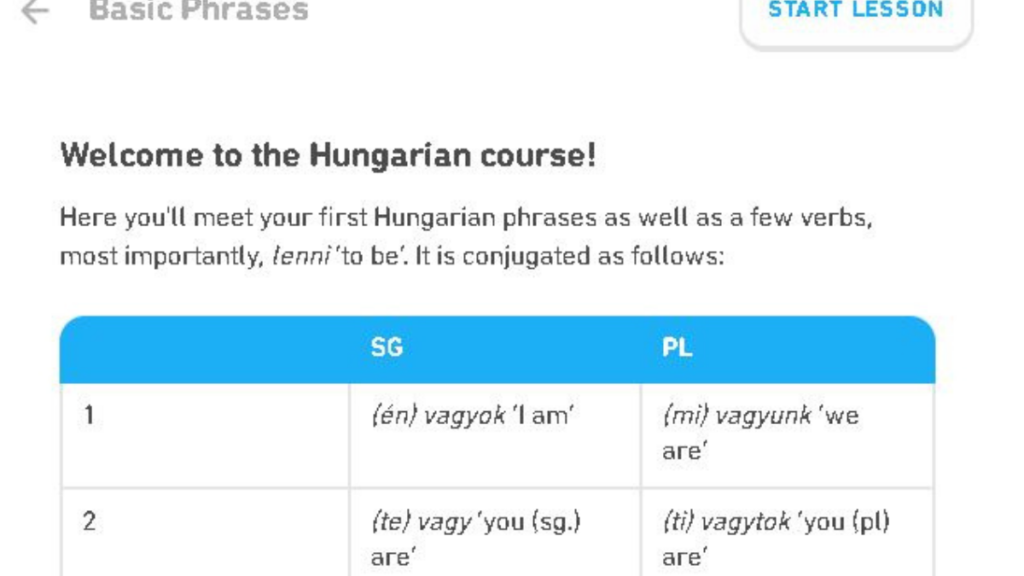
However, I felt that some of the tips pages were limited.
For example, in the first ‘tips’ section some guidance was given on pronunciation and reading the alphabet.
However, this was quite limited and instead they directed you out to an external source to learn the alphabet properly in your own time.
If you want a course that is going to properly guide you through how to read Hungarian then Duolingo is definitely not the best choice.
Perhaps this will change when the Hungarian course eventually changes from ‘Beta’ to a more complete course.
Stories
Stories are a feature of some Duolingo courses where you are given short stories to help your comprehension of the language.
Unfortunately Duolingo Hungarian does NOT currently have any stories. This is a shame because in the past I have found these super helpful when doing other Duolingo courses and I do think they are fantastic for improving your comprehension skills.
Podcasts / Guided Audio Lessons
Unfortunately the Duolingo Hungarian course doesn’t currently have any podcasts or guided audio lessons. They have introduced this as a feature on some courses but not on Hungarian yet.
Teaching Style
When doing new lessons on Duolingo they tend to teach you new words/phrases by giving you a few new words often by just asking you to select the correct meaning and showing you a picture to help.
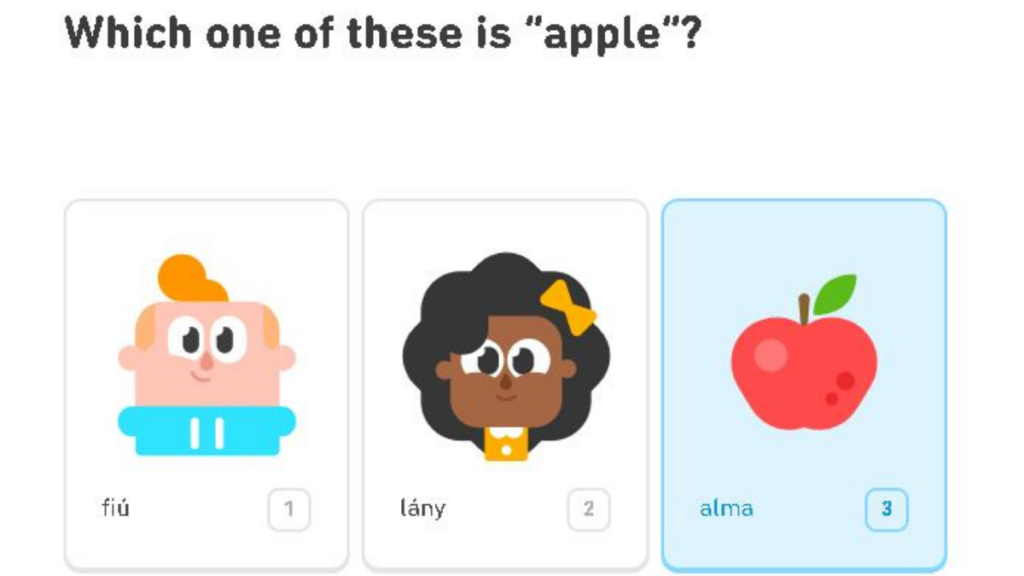
After that you get a range of exercises to practice including translating from English to Hungarian and also from Hungarian to English. There are also exercises where you listen to phrases in Hungarian and write the phrases in either Hungarian or English.
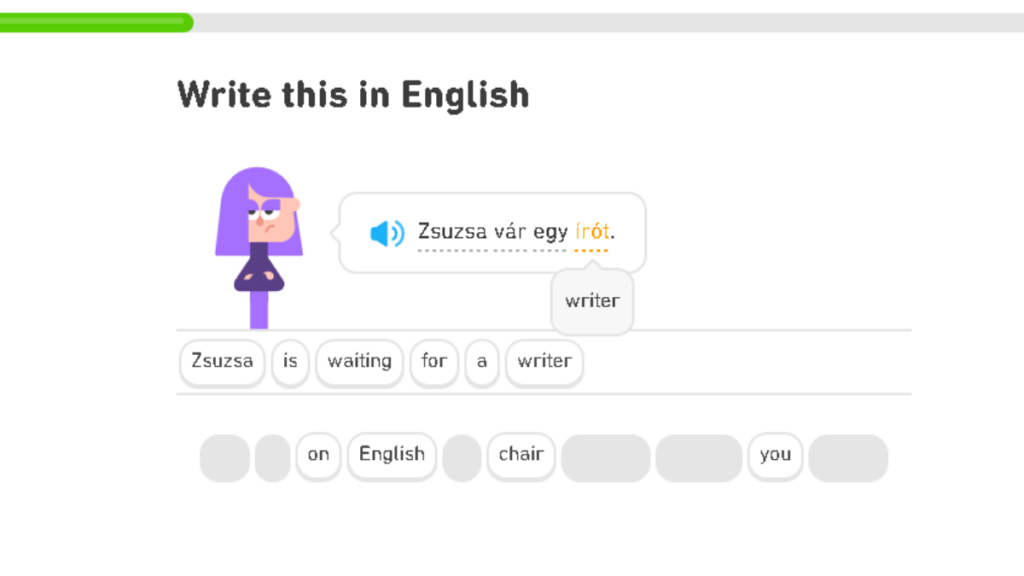
In each new lesson, Duolingo usually introduces a few new words and then uses these words in sentences that you’ve previously learnt in other topics so you can focus on learning the new words.
I found this to be really effective because you can consolidate other things that you’ve learnt and really get to grips with the new words. This is especially good for hard concepts as you can focus just on the new concept.
Speaking & Listening
Learning Pronunciation
The Duolingo Hungarian course was okay at teaching pronunciation of words.
Every single word and sentence included in the course has a sound clip to go with it so you can hear the correct pronunciation of the word/phrase.
The audio quality was very good and it sounded like a native speaker.
As I mentioned earlier, in one of the tips sections they tried to explain some of the reading and pronunciation of the alphabet in the ‘tips’ section but this was limited.
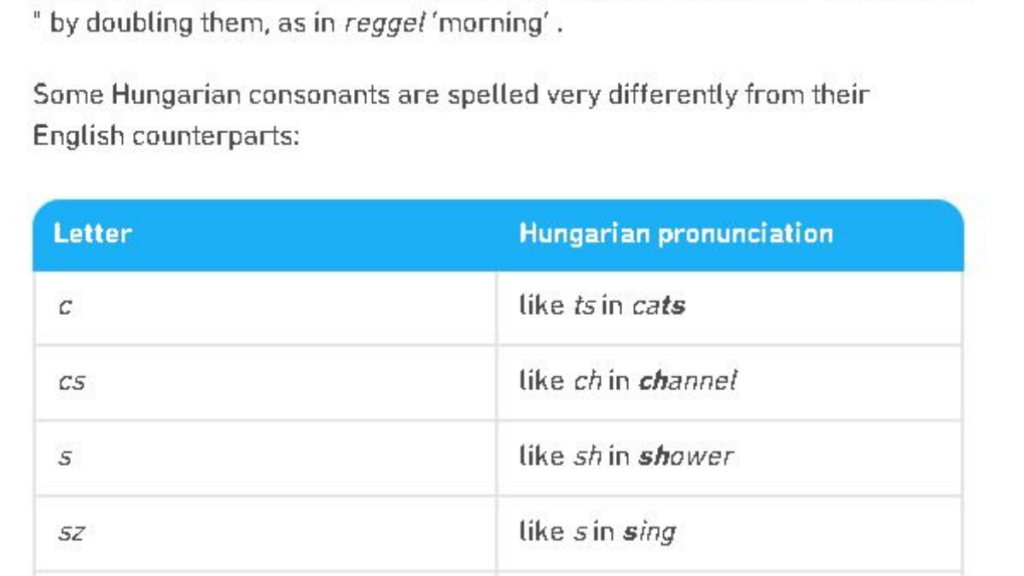
The good quality audio helped to make up for the fact that there was limited guidance on pronunciation.
I found that the more I practiced and the more lessons I did, the easier pronunciation became.
I didn’t spend ages studying the alphabet. The link they provided was a video to learn the Hungarian alphabet where someone goes through the pronunciation of each letter.
I tried to focus my time on using the exercises within the Duolingo course to make it a fair test of how good Duolingo is at teaching you Hungarian and not other resources.
As you see more words and hear the pronunciation you tend to pick up on the correct sounds.
Of course this takes time and I’m sure there are plenty of errors in my pronunciation after just 30 days.
Voice Recognition
In some Duolingo courses they include voice recognition. This is where a word/phrase will appear on the screen and you have to say the word/phrase out loud into the microphone.
Duolingo will then tell you if you pronounced it correctly or not.
Unfortunately, the Hungarian Duolingo course does NOT include these types of exercises which is a shame because I have found them to be useful when doing other Duolingo courses.
There’s not much opportunity to practice speaking when doing the Duolingo course, so it’s a shame that there were no voice recognition exercises.
This is definitely a negative of the Duolingo Hungarian course.
Fluency in Conversation
Fluency or being able to hold a conversation with someone in Hungarian is probably one of the main reasons that anyone would choose to start the Duolingo Hungarian course.
After doing the Duolingo Hungarian course for 30 days, I wouldn’t be confident at all in speaking with someone in Hungarian.
Of course, after just 30 days there’s no way I would ever be at a fluent level, but I’d even say that after this short time I wouldn’t be confident at all to say much more than some basic greetings and phrases.
One of the main negatives of the Duolingo Hungarian course is that there isn’t much speaking practice. It’s all reading and writing.
To get fluent in speaking in a new language you need to practice speaking it!
The best way to practice speaking is to force yourself to say all the words/phrases out loud as they appear on the screen even if you don’t need to.
The more you say the words, the more they will be consolidated in your brain and they’ll come naturally to you later when you try to use them.
This is something that you will need to do for yourself though as Duolingo doesn’t ask you or require you to say the words out loud.
One problem with this approach is that there won’t be any error correction for you if you are saying the phrases with incorrect pronunciation.
The lack of speaking practice means that I can’t confidently recall many of the words and phrases that I learnt during the course and say them.
I’m quite confident in recognising words when they appear in front of me, but recall is much harder. This is important because recall is essential when you want to speak a language.
If speaking is your main goal then I’d suggest picking a Hungarian course that focuses on speaking such as Pimsleur.
I’ve done Pimsleur courses in the past and they get you speaking from day 1 and teach you useful phrases that you are likely to use.
Listening Comprehension
The Duolingo Hungarian course did include lots of listening exercises.
This is where they play you an audio clip of a word or phrase and you then have to try and write what was said.
To start with they will provide words to choose from, but in the higher level lessons these are removed to test your recall abilities and to make it more challenging.
This is a great exercise to test your listening skills in the Hungarian language.
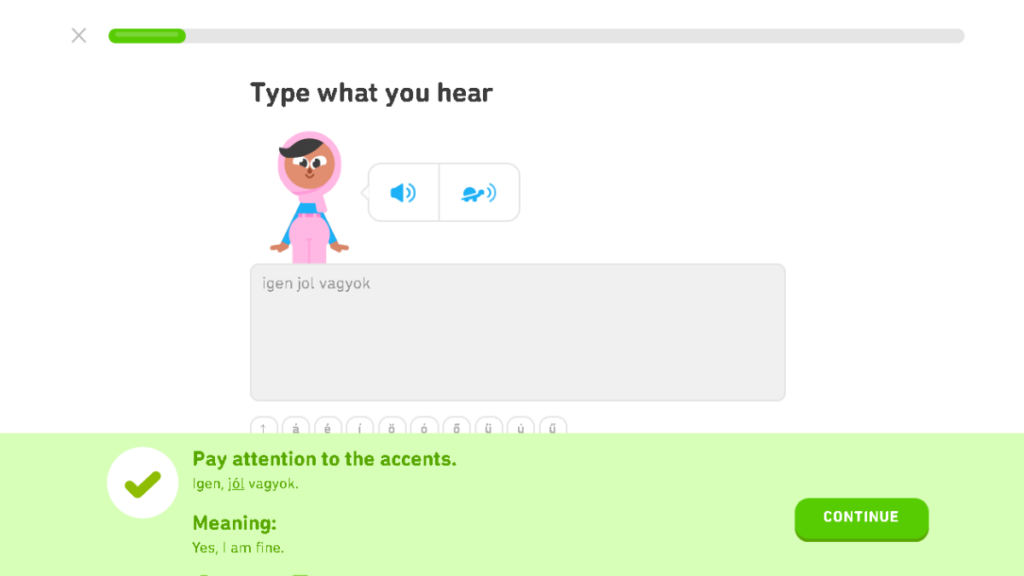
I found these listening exercises to be really effective as we often rely on the words on the screen when listening.
When we read and listen to a sentence at the same time we often think we are good at listening but then when we listen to it on it’s own it can be difficult to understand.
This is mainly because we get the understanding from the written words without realizing it.
For example, many people find that when watching a video/TV show in their target language with subtitles they can understand what is being said.
However when they watch the same video/TV show without subtitles they struggle to understand it at all.
For this reason, I think the listening exercises are essential and I found them to be very beneficial to learning.
I don’t think you can successfully learn to listen to Hungarian without dedicated practice like this so this is definitely a good aspect of the Duolingo Hungarian course.
Reading & Writing
Learning To Read The Script
Luckily, learning to read the Hungarian script wasn’t too difficult as it uses mostly the same letters as English with just a few variations in pronunciation and a few additional letters.
While it wasn’t too hard to recognise the letters, some of the vowels were particularly hard to get right and sometimes it’s hard to tell the difference between them. To be perfectly honest I still don’t know if I am getting the vowel sounds correct.
The consonants were difficult to start, but I think they were easier to recognise and say compared to some of the vowels.
The tips section only had limited guidance on pronunciation which included a link to an external video and I mostly tried to pick up pronunciation just from listening to the words/phrases in the course.
Writing In Hungarian
I found that at times writing in Hungarian was actually one of the hardest parts of the Duolingo course.
One word that I struggled with for ages was the word for ‘goodbye’.
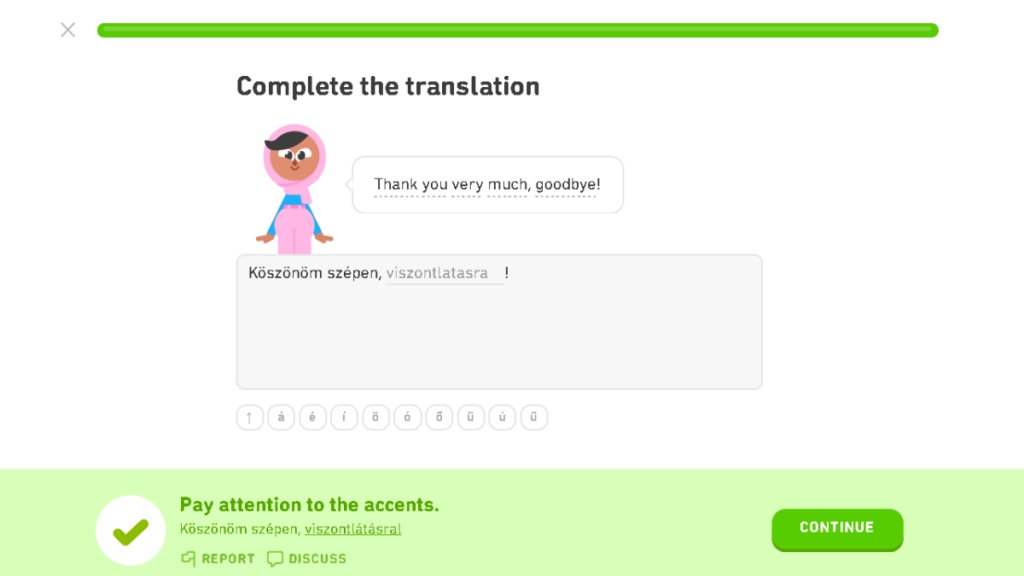
Above you can see the exercise where I finally got the letters in the right order after 4 attempts! Even then I did not include the accents, but Duolingo is a bit forgiving with accents.
If you showed me the word in Hungarian I would know instantly that it was goodbye. But spelling it correctly from memory was much harder.
Duolingo often gives these exercises where they give you an English word/phrase and ask you to type it in Hungarian.
I found these to be some of the most difficult exercises on the course, but I do think they’re really important as you need to be able to recall the words.
Towards the end of the 30 days, I could spell more words with better accuracy as the patterns made more sense.
Of course as the Duolingo course is virtual, the writing practice mentioned here is actually typing practice – I still haven’t actually physically written any Hungarian words with a pen yet. This is something you’d need to do in your own time if you wanted to practice it.
One negative point of the Duolingo course is that during these writing exercises, Duolingo accepts words that are written without the correct accents.
You can see in the image below that Duolingo has accepted my answer as correct even though there are 4 missing accents!
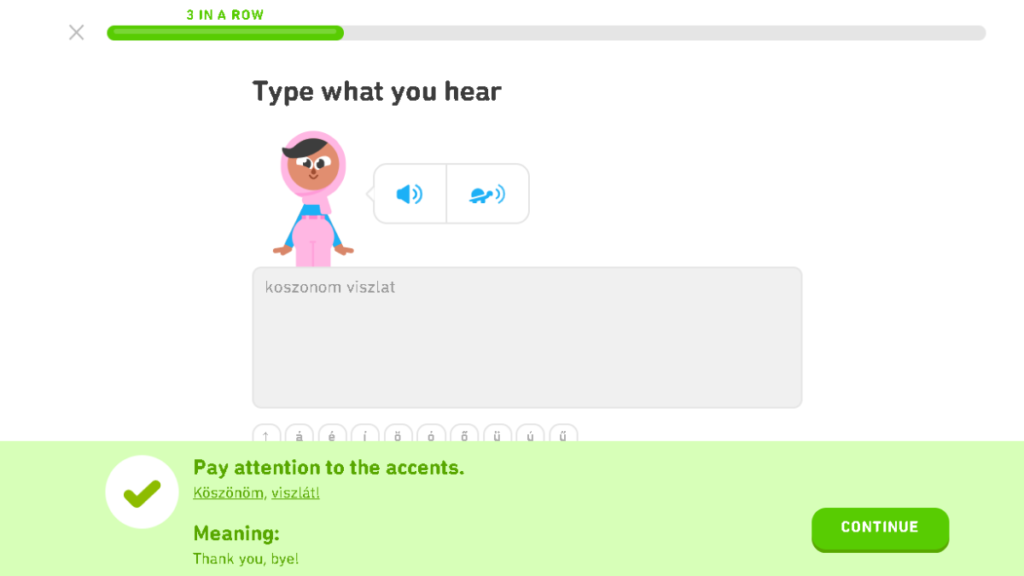
Whilst I understand why they have allowed this, I don’t think it actually helps learners because when writing or typing in real life they would need to use the correct accent marks.
It leads to learners not learning correct spellings which will hinder them in the future as they learn bad habits.
Verbs & Tenses Covered
Tenses are super important when it comes to learning a new language. After completing 30 days of the Duolingo Hungarian course, I have only used the present tense.
I think it would have been nice to have learnt another tense, especially past tense as I would like to be able to discuss things that happened in the past.
Having said this, Hungarian is different to English as it has something called ‘cases’.
Cases – Cases are a grammatical concept where the ending of a noun or pronoun changes depending on the context.
Although I would have liked to have learnt some past tense theres only so much content you can cover doing 20 minutes in 30 days. The course so far did focus a lot on consolidating cases like the accusative case.
Since cases are a foreign concept when compared to the English language it’s probably a good thing that we spent time on this as it can be quite tricky.
I found that Duolingo did an okay job of teaching the cases which have a reputation to be tricky to learn. The tips were definitely useful for this.
The accusative case was introduced after covering some basics, and lots of examples were used in the lessons to build on existing knowledge.
Vocabulary Building And Relevancy
Overall I was happy with the vocabulary that Duolingo taught. Most of the vocabulary that was introduced to me was relevant and useful.
The first few lessons taught us words like boy, girl, man, woman, apple, window, lamp etc.
There were also topics that tended to focus on a particular vocabulary type. For example, there was a topic on ‘places’ which taught you words for things like hospital, department store, station etc.
I have mixed feelings about some of the phrases and sentences taught. Duolingo does teach you basic things like how to say where something is, or what someone is doing but I also found that some of the sentences were quite complex for a beginner.
Here’s a few examples of the phrases that come up:
- “The Hungarian cars are new and beautiful”
- “Who is standing in front of the store?”
- “I’m standing in front of the tall building”
- “The composers are not here but there”
- “Are they Russian or Italian?”
- “The Dutch buildings are tall and beautiful”
- “The rich, old woman is eating lunch in front of the expensive restaurant”
As you can see some of the phrases are quite challenging for a beginner and sometimes I do wish the pace was slower when it comes to the complexity of the sentences. There’s no way I would be able to say that last sentence from memory.
But at the same time they were definitely challenging and made sure to include various types of vocabulary and grammar. If you are some sort of polyglot prodigy then you’d probably enjoy the pace.
There were also some phrases that just seemed strange or irrelevant.
Here’s some examples of some of the phrases which I thought were a bit strange.
- “I am shouting by the old table”
- “Do you hear those apples?”
- “Those kindergarten teachers are over the cities”
I’m not sure why phrases like this are included and they seem like a waste of time.
Memory/SRS
Being able to remember and recall words and phrases in Hungarian is one of the most important things for a language learner.
Overall, I found that Duolingo tends to focus on reading more than anything else, but they do include exercises where you have to recall and type words and phrases from memory.
Recall is usually much harder than reading a phrase in Hungarian and translating it into English.
I’d say I’m much better at reading in Hungarian than writing/speaking Hungarian as my recall isn’t as good as my recognition so it would have been good if Duolingo focused on this a bit more.
I also found that you have to have a plan on how you’re going to use Duolingo to ensure you don’t forget words that you’ve already learnt.
It’s up to you how long you spend on each topic before moving onto the next and it’s up to you to go back to previous topics and review them.
This can be difficult for a new language learner because after a while there’s a lot of older topics that need reviewing and I can’t always remember when I last reviewed a particular topic and when’s the best time to review it again.
SRS or a spaced repetition system is best for this but Duolingo doesn’t really use SRS.
SRS is a method where a learner is asked to recall a certain word/phrase with the time intervals increasing each time the word is presented.
While Duolingo does claim to be using SRS, it doesn’t really match up to other software like Anki. I saw little evidence of SRS use when doing the course.
The only evidence I found was in the ‘words learnt’ section where Duolingo rates how strongly you know the word.
However, I found that there are some words that Duolingo says I am strong at which I would struggle to remember.
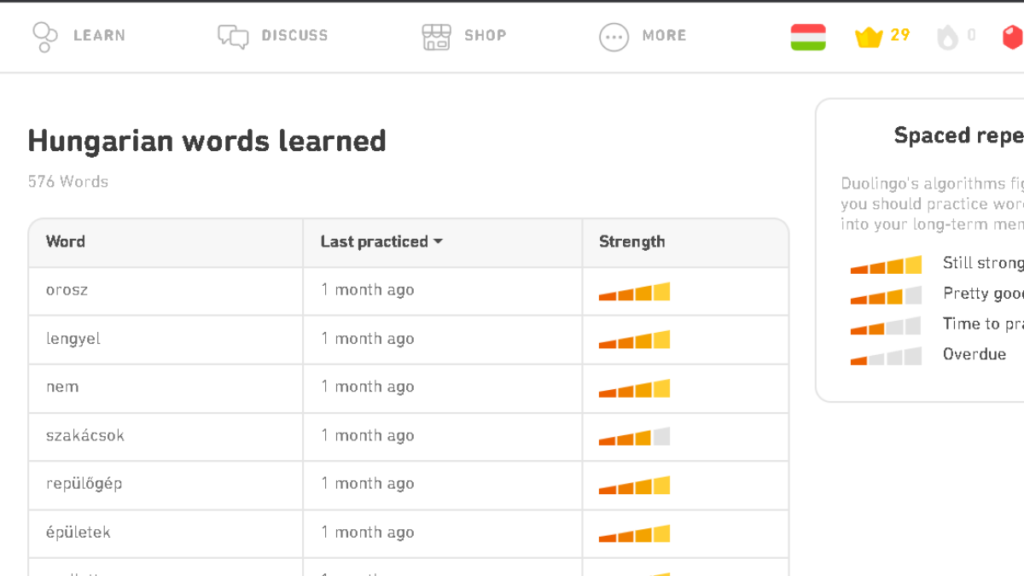
I think the Duolingo Hungarian course could be improved by incorporating a more structured review process to ensure you don’t forget anything you learn in previous lessons.
Was It Fun?
One of the main positives of using something like Duolingo to learn a new language is that it is a gamified course.
They have lots of incentives that help you to come back everyday and do a few lessons.
These include the streak, where you build up a streak everyday that you do Duolingo.
They also have leaderboards where you compete against other people to build points and finish top of your league.
I found the actual course and content to be quite enjoyable, it’s not boring like reading a textbook.
The exercises are varied so you don’t get bored. I definitely think that it would be easy to keep up this routine and complete the entire course.
Overall Progression
Overall I am somewhat happy with the progress I made doing 30 days of Hungarian on Duolingo.
In terms of the course progress, I passed checkpoint 1.
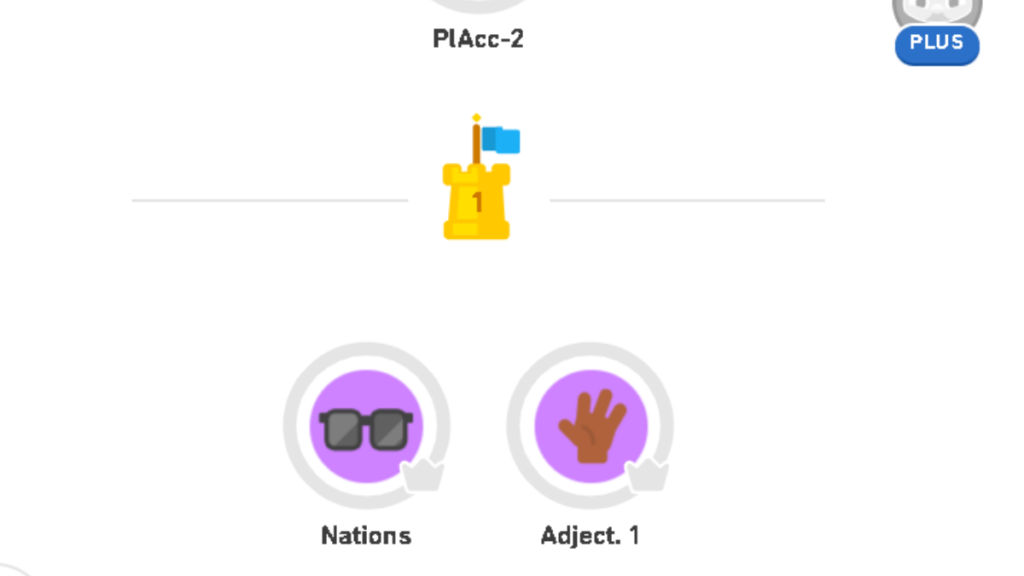
As an introduction to the language for a beginner, I think Duolingo does a good job of introducing some basic words, verbs, phrases and concepts.
They do introduce new concepts well. There’s tons of practice so you can really become confident using the new words and phrases that you’ve learnt.
I found that the Hungarian course was a bit fast when it came to introducing new words and complex sentences.
As I mentioned before, I found that Duolingo Hungarian wasn’t great for someone looking to speak the language as there’s basically no speaking practice.
If your main goal is to be able to speak then you’d be better with an audio course like Pimsleur.
If you’re serious about learning Hungarian then I’d recommend trying Pimsleur for FREE before purchasing.
Can You Actually Learn The Hungarian Language With Duolingo?
If you want to become fluent in Hungarian then you won’t be able to do this with Duolingo alone.
Becoming fully fluent will require lots of different inputs including videos, books, audio lessons and much more.
Duolingo alone won’t get you there but as I said before it is a great introduction to the language.
Is Duolingo Hungarian Worth It Or Is It A Waste Of Time?
Even though I don’t think you could become fluent in Hungarian with Duolingo alone, I think it could be worth doing especially if you are a beginner and have no prior knowledge of Hungarian.
It does a good job of teaching you basic concepts, words and phrases and is good at getting you used to the sounds of the language at no cost.
If your aim is to become a fluent Hungarian speaker then it may be still worth doing the course as there’s lots of opportunity to practice and become exposed to the language.
However, I’d recommend doing another course such as Pimsleur as your main form of learning and just use Duolingo as a supplementary resource.
As I have mentioned in the article there are some limitations to the Duolingo Hungarian course:
- Lack of speaking practice
- Lack of pronunciation/reading guidance
- Some strange phrases taught
- Pacing being a bit fast at times
- Encouraging bad habits for spelling
If you are limited on time and serious about learning to speak the language, then I would choose another more comprehensive resource to get the best out of your time.
Alternatives To Duolingo
There’s plenty of alternatives to Duolingo if you’re wanting to learn Hungarian fluently.
My top recommendation is Pimsleur. This audio course will get you speaking from day 1 and has tons of content to build up your confidence and speaking level.
If you’re serious about learning Hungarian, then I’d recommend trying Pimsleur Hungarian for FREE before purchasing – they always have either a free lesson/free trial.
Another fantastic option for learning Hungarian is Glossika.
They help you to speak a new language quickly with their clever algorithms.
Glossika is also an audio-based course which I think is essential if you want to be a fluent speaker of Hungarian.
Glossika allows you to acquire grammar and vocabulary through phrases and complete sentences (rather than memorizing grammar).
Finally, HungarianPod101 is a great resource for someone looking to learn Hungarian fluently.
They feature both audio and video lessons recorded by native Hungarian teachers who will explain everything to you in simple terms. They also have word lists and flashcards to help you study.
If you’re on a budget then HungarianPod101 has a great YouTube channel that covers lots of content and it’s free.
Check out one of their most popular videos below:
Thanks for reading this Duolingo Hungarian review.
I spent 30 days testing out the Duolingo Hungarian course to find out if it’s worth it. If you want to try out the language then it’s a great introduction.
If you’re interested in learning more Hungarian then check our other Hungarian content here.
Related Posts:
